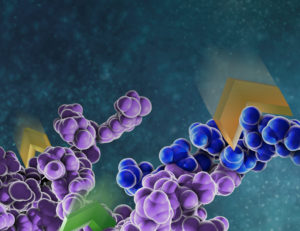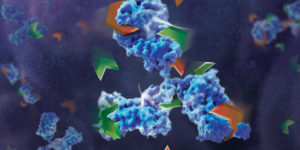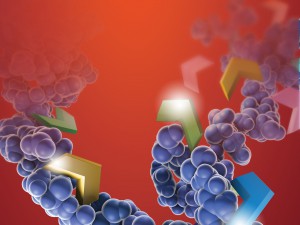It’s time to analyze your protein and you are trying to decide where to begin. You are asking questions like: Which protease do I choose? How much enzyme should I use in my digest? How long should I perform my digest?
Unfortunately, there is no one-size fits all answer to this type of question other than… “well it depends.” All protease digests will be a balance between denaturing the protein sample to allow access to cleavage sites, optimizing conditions for the protease to function, and compatibility with your workflow and downstream applications. We provide general guidelines that work for most samples, but frequently you will need to optimize the conditions need for your specific sample and application.
Here, I use the example of a trypsin digest for downstream mass spectrometry to highlight key questions to ask and factors that can be optimized for any digest.
- Sample Preparation: How will the protein(s) of interest be purified and separated? Will the protein(s) stay in the solution? Will there be enough protein to detect the resulting peptides using the method of choice? Are the reagents compatible with the protease digest and the downstream application?
- Proteins are typically purified from cell lysates or in vitro translation reactions. Many lysis and extraction buffers use detergents/surfactants that are not compatible with mass spectrometry, and these detergents and surfactants can inhibit the activity of proteases like trypsin if they are present in concentrations greater than 1% in the final digest. These components need to be diluted or removed prior to mass spectrometry analysis. Alternatively, mass spectrometry compatible surfactants, like ProteaseMAX™ Surfactant, Trypsin Enhancer, can be used. ProteaseMAX™ is useful in the purification stage to help extract proteins (especially membrane proteins), and during protease digests to help keep the proteins in solution. ProteaseMAX™ also enhances protein digestion and peptide extraction for in-gel protein digests.
- Protein mixtures can be further processed in many ways to separate and enrich for the proteins of interest. The Protocols and Applications guide to Protein Purification and Analysis is a good resource for further details.
- Mass spectrometry is a sensitive detection method that can detect peptides in the picogram (10—12g) and lower range. For comparison, a single protein band on a gel can be detected with Colloidal Coomassie staining in the 10–20ng (10–9g) range. If you can see the protein on a gel with Coomassie staining, you should have sufficient protein for mass spectrometry detection.
 Selecting the Protease(s): What peptide fragments are needed for the downstream application? Does the downstream application tolerate missed cleavages? Are the reagents used for sample preparation compatible with the protease?
Selecting the Protease(s): What peptide fragments are needed for the downstream application? Does the downstream application tolerate missed cleavages? Are the reagents used for sample preparation compatible with the protease?
- Trypsin is most commonly used to digest proteins for mass spectrometry applications because it cleaves specifically at the carboxylic side of lysine and arginine residues; the resulting peptides are on average the desired size for mass spectrometry with a strong C-terminal charge that can be efficiently ionized, and it is robust in a variety of conditions. This means you can predict the expected peptide fragments and get the desired results consistently, which allows for efficient protein identification, sequencing, quantitation, and characterization.
- Digesting with additional proteases like Lys-C can help reduce missed cleavages at lysine residues and improve sequence coverage. Alternative proteases are helpful when the resulting tryptic digest peptides are not of optimal size, and complimentary alternative digests can improve protein analysis with mass spectrometry. For alternative proteases, the protein(s) are typically digested in separate reactions, then either the peptide fragments are combined prior to mass spectrometry analysis or the resulting data is combined after analysis.
- Digesting with multiple proteases in the same reaction often requires extensive optimization. Promega has optimized several Trypsin/Lys-C mixes for improved protein digestion.
- A good resource for choosing the protease(s) to best suit your needs for this application is our guide for Protein Characterization by Mass Spectrometry.
- Denaturation, Reduction, and Alkylation: Will the protein sample be fully denatured so that all the cleavage sites are available for digest? Will the denaturant concentration inhibit the protease? Are the reagents compatible with the downstream application?
- Fully denaturing the protein so that all cleavage sites are available may be more important than maintaining the maximum activity of the protease.
- Unexpected peptides are often missed cleavages!
- Common reagents to denature a sample include urea, guanidine, organic solvents, detergents, or heat.
- These reagents can inhibit proteases, but Promega Trypsin Gold is resistant to mild denaturing conditions like 1M urea or 10% acetonitrile, and retains ~50% of its activity in 2M guanidine HCl.
- Detergents like Triton™ X-100, CHAPS, NP-40 and Tween® 20 inhibit trypsin at concentrations higher than 1%, and SDS inhibits trypsin at concentrations higher than 0.05% in the final reaction.
- Reduction cleaves disulfide bonds between cysteines and alkylation prevents the reformation of these bonds, which improves access to the cleavage sites.
- Trypsin is inhibited by final concentrations of reducing agents like dithiothreitol (DTT) at higher than 20mM, and tris(2-carboxyethyl)phosphine (TCEP) or Tributylphosphine (TBP) at higher than 5mM.
- Fully denaturing the protein so that all cleavage sites are available may be more important than maintaining the maximum activity of the protease.
 Digestion: Modifications to the digest can help compensate for reduced activity of the protease. Can the reagents be diluted to reduce inhibition of the protease? Does the time of the digest fit into the workflow? Is it important for the downstream application to digest the protein fully? Does it matter for the application if the sample undergoes nonenzymatic posttranslational modifications (PTMs) during preparation?
Digestion: Modifications to the digest can help compensate for reduced activity of the protease. Can the reagents be diluted to reduce inhibition of the protease? Does the time of the digest fit into the workflow? Is it important for the downstream application to digest the protein fully? Does it matter for the application if the sample undergoes nonenzymatic posttranslational modifications (PTMs) during preparation?
- Protease modification: Trypsin can also digest itself, known as autolysis, autolytic digestion, or autodigest. Trypsin Gold is modified by reductive methylation of lysine residues, yielding a highly active and stable molecule that is extremely resistant to autolytic digestion. Although the amount of autolytic digestion is greatly reduced compared to unmodified trypsin, peptides produced by autolytic digestion, including at the unprotected arginine residues, can still be detected with mass spectrometry.
- The most common autolysis peptides are seen as spectrogram peaks at 842 (VATVSLPR) and 2211 (LGEHNIDVLEGNEQFINAAK).
- Optimal buffer: Typical in-solution trypsin digests buffers include 50mM Tris-HCl (pH 8) or 50mM ammonium bicarbonate (pH 7.8) [See Note below].
- If reagents that inhibit the protease must be used, they can be reduced by dilution or exchanging the buffer. With most inhibitors the protease can usually still function, though the digest will not be optimal. It will take more protease and/or a longer time to digest the sample fully.
- Optimal pH: Trypsin is maximally active in the range of pH 7–9 and is reversibly inactivated at pH <4.
- The AccuMAP™ Low pH Protein Digestion Kit helps suppress nonenzymatic PTMs during protein sample preparation. Reduction and alkylation steps are performed at pH 5.6 to 5.8, and then the pH is shifted to 5.2 to 5.4 at the digestion step.
- Temperature: The optimal temperature for trypsin is ~37°C.
- Heat can help denature the sample but it will also change the activity of the protease.
- Heat can induce artificial PTMs that may not be wanted.
- The Rapid Digestion–Trypsin and Rapid Digestion–Trypsin/Lys-C Kits are optimized to incubate at 70°C for as little as 60 minutes.
- Note: For the Rapid Digest kits, avoid the use of phosphate or carbonate buffers! The protein sample should be resuspended in pure water, mildly-buffered solutions like Tris buffers at a concentration of 25mM or lower, pH 7.0–8.0.
- Digest Time: A trypsin digest can take as little as one hour but it is typically performed overnight.
- The rate of a protease reaction increases as the temperature is raised, up to a maximum, after which the protease starts to denature and activity sharply declines. The optimal digest time is a balance of temperature, enzyme concentration, and need to digest the sample fully. Less than optimal conditions require more protease and/or time to complete the digest.
- Protease/Sample Concentration: The digest is a kinetic enzymatic reaction in which the sample substrate and protease concentration will change the velocity of the reaction.
- The final protease:sample ratio for trypsin is typically in the range of 1:100 to 1:20 by weight (w/w). However, the specific activity of trypsin can vary so procedures describing the use of trypsin by weight may need to be optimized depending on the specific activity of the trypsin being used.
- Enrichment/Cleanup: Samples can be enriched by affinity purification or fractionation before and/or after digest to reduce the complexity and concentrate the sample. Mass spectrometry is not compatible with non-volatile agents like salts, detergents, chaotropic agents, and solvents like DMSO or glycerol. These should be avoided or samples must be cleaned up prior to analysis.
- IgG enrichment usually requires either Protein A, Protein G, or streptavidin beads coated with a biotinylated capture reagent.
- The High Capacity Magne® Streptavidin Beads have been tested for on-bead based digestion with the Rapid Digest kit for a flexible and rapid workflow.
- Salts and buffers can be removed using C-18 tips or columns, and detergents can be removed using affinity columns or detergent-precipitating reagents.
- IgG enrichment usually requires either Protein A, Protein G, or streptavidin beads coated with a biotinylated capture reagent.
- Protease modification: Trypsin can also digest itself, known as autolysis, autolytic digestion, or autodigest. Trypsin Gold is modified by reductive methylation of lysine residues, yielding a highly active and stable molecule that is extremely resistant to autolytic digestion. Although the amount of autolytic digestion is greatly reduced compared to unmodified trypsin, peptides produced by autolytic digestion, including at the unprotected arginine residues, can still be detected with mass spectrometry.
Are you looking for proteases to use in your research?
Explore our portfolio of proteases today.
As always, we in Technical services are happy to help you with questions you may have as you design and move forward your protease digest project.
Try a sample of high-efficiency Trypsin Platinum today!
Visit our website for more on Trypsin Platinum, Mass Spectrometry Grade, with enhanced proteolytic efficiency and superior autoproteolytic resistance.
Related Posts
Latest posts by Joliene Lindholm (see all)
- A Day in the Life of a Technical Services Scientist - May 24, 2021
- Oh, The Ways You Can “Glo” - February 22, 2021
- Designing a Reporter Construct for Analyzing Gene Regulation - December 10, 2019

